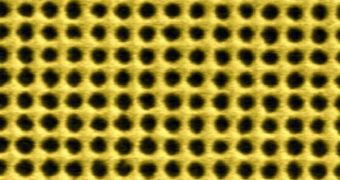The dual nature of light, as in the fact that it can act like both a particle and a wave, has had physicists puzzled since that was first discovered. Such a duality was bound to lead to some paradoxes, scientists hypothesized at the time, and now their predictions appear to be coming true. Scientists have recently discovered a paradox that makes no sense, but that occurs nonetheless. When they attempt to pass light through an already transparent, ultra-small layer of gold atoms that has received many holes priorly, less light goes through than it would through a layer without holes.
Even kindergarten children will tell you that, if you pierce a hole through a piece of paper, and then point it at the Sun, a beam will pass through and light the ground below. This is as intuitive as gravity, yet this type of behavior appears to not be entirely oblivious to the type of holes it passes through. This was discovered some time ago, when scientists looked at the obstacles that the diffraction limit threw in the way of developing state-of-the-art optical electronics.
They explain that the wave nature of light does not allow it to pass through openings that are smaller than half of its wavelength. This means that, for a 400-nanometer wavelength, the light can only pass through openings that are more than 200 nanometers large. As the researchers were investigating this, they discovered newly formed particles on the surface of the hole-laden material, called plasmons. The plasmons are believed to be, in fact, waves of electrons that are created by the incoming photons, as they cannot pass through.
Since then, the plasmonics field of research has determined that plasmons spread on the surface of dotted thin metal films, combine with each other, and then pass through, carrying the photons with them in the process. This is made possible by the fact that the waves have a much shorter wavelength than that of the incoming light. One possible application for the find is the development of light-based integrated circuits that would be just as effective as carrying photons as fiber optics, but without being so large, ScienceNow reports.
In the new experiments, led by German scientists at the University of Stuttgart, a very thin, 20-nanometer gold film was placed on a glass substrate. Ion beams were then used to pierce the material in a regular, square array. The thing is that, because the gold layer was so thin, light could already pass through it. But, after the tiny holes were added, less light than before shone through the material. In a paper published in this week's issue of the journal Physical Review Letters, the team explains that the key to this mystery is the interference between the geometry of the holes and the transmission of light.
The German team explains that, after holes are added to the gold film, almost 40 percent of the incoming light starts forming plasmons on its surface. However, because the wavelength of light is not tuned to the geometry of the holes, the other 60 percent of light simply does not create plasmons, therefore it cannot pass through the small holes. Without the holes, much more light is able to shine through the transparent material.

 14 DAY TRIAL //
14 DAY TRIAL //